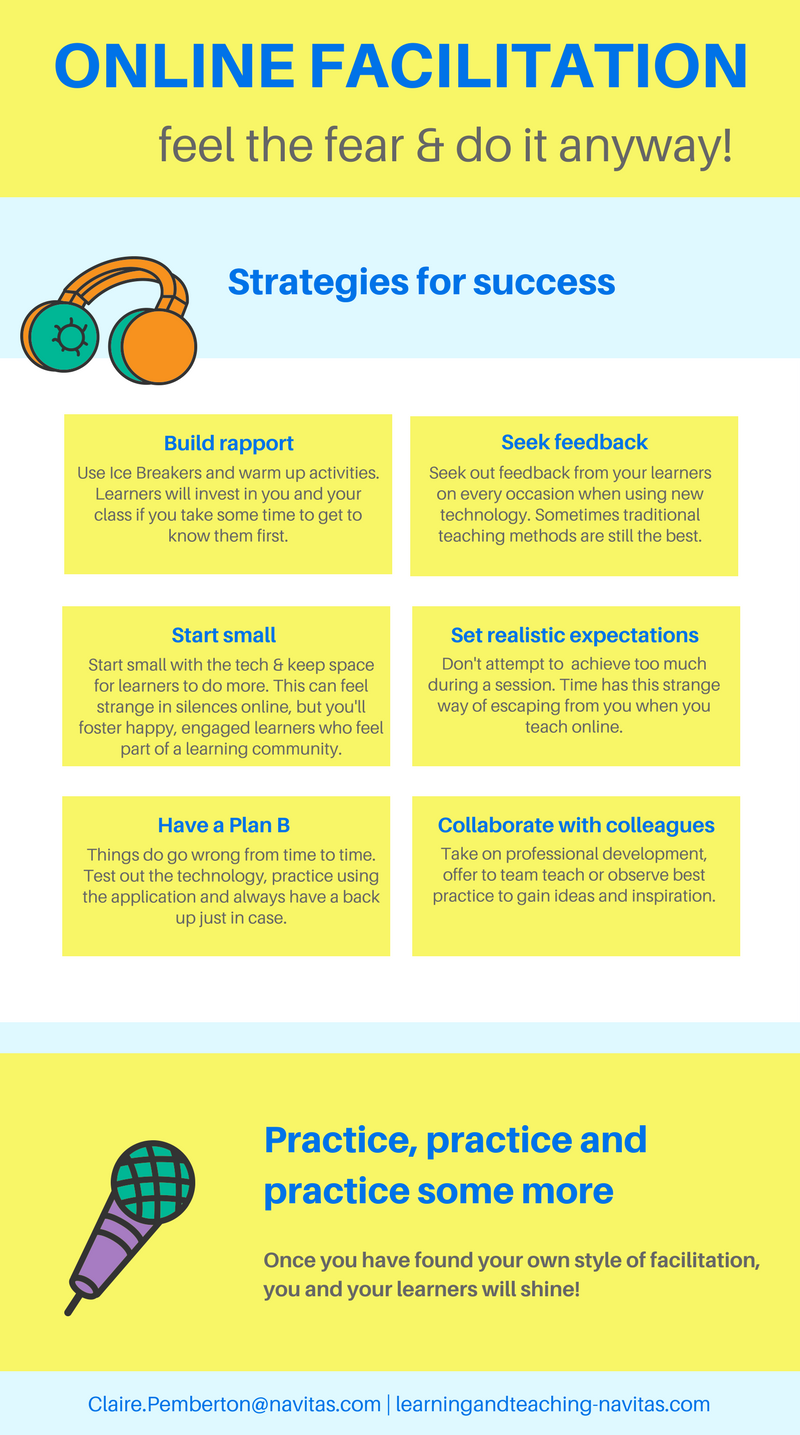Feel the Fear & Facilitate Your Way! Lessons learnt in successful online facilitation

Why do so many of us fear the online space when it comes to teaching and facilitation? What’s more, how can we overcome this?
Four years ago I found myself asking the same questions, having relocated from Sydney to regional Australia with my young family. After 17 years of largely face-to-face (and some online) teaching, I found myself facing the Zoom screen and not the smart board for the first time in my career.
Okay, so what were these fears after I set up the computer and scheduling for my first online sessions with learners? Firstly, I was largely working in an unfamiliar territory. I was nervous around new technologies such as Moodle and Zoom and I questioned how capable I was to make use of them successfully in my day-to-day teaching practice. I had this huge fear of not being able to get my message across in the same way as I had done in a classroom context. At times I felt a sense of loss from traditional classroom teaching methods as I worried about the lack of engagement by my learners.
Was I able to capture a true learning experience?
Do I have the time to set up the technology to assist in supporting my role online?
Forging ahead
I realised that to address this fear of facilitating online I had to find my own facilitation style, just like I had 17 years ago, this time with the help of some wonderful educational technology.
I learnt quickly that taking some time to build rapport with my learners made a big difference to the online space. My learners are online but they are still my class, so I learnt to make the most of the time we spent together in the online space, using ice-breakers, welcome videos and activities to boost engagement wherever I saw possible. I think this is such an important part of establishing yourself online, as engagement & belonging go hand-in-hand.
Learners will invest in you and your classes if you take some time to get to know them first. Recognising that I could utilise the online space to be creative was an important step in reminding myself that teaching is NOT a simple delivery system, it is a highly creative profession, and so if I can take some time to work with this new technology, I could create a dynamic and engaging space. I wanted to remain authentic and true to myself. I didn’t need to change or act differently online; I just needed to be myself. Even the most famous generation bloggers and YouTubers are just everyday people talking about their passions.
Building a professional network
Importantly, I spent time taking online PD courses with L&T services, attending workshops and training days and embraced that the use of technology would assist me in adapting to my role online as well as engaging my learners. My aim was to try something different every now and again in my teaching practice and crucially I learnt to make space for learners to do more.
Whilst at times I still craved a busy staffroom and good coffee, I realised that I could join forces with other educators and share ideas and resources (just not the coffee run)!
I believe that team teaching is highly valuable and goes a long way at assisting you to perfect your own style of facilitation so considering a mentor was very important for me. Having an opportunity to work together in a Zoom session online with another colleague was highly valuable and I learnt so much from them. I also felt supported in my role and recognised that you really don’t need to go it alone online.
Where possible create a community of practice to share your ideas and experiment with the technology. It is so important to consider the pedagogy around educational technology and use this to support your role- not replace it.
Lessons along the way
Teachers remain central to the learning experience regardless of whether you are face-to-face at 9am in the morning or working with learners at 8pm in the evening via zoom conferencing. These are the key lessons I have picked up in my practices, on this journey towards successful online facilitation:
- Start small with the technology and pull back to make space for learners to do more. This can feel really strange online, as your tendency is to keep talking, rather than work with the silences. The rewards however will come from your happy and engaged learners who feel part of a learning community.
- Have a Plan B/ back-up plan for when things go wrong (and they will from time to time). Test out the technology, practice using the application and always have a back up just in case.
- Set realistic expectations about what you want to achieve during a session- Time has this strange way of escaping from you when you teach online.
- Foster a culture of collaboration and mentoring with colleagues – Take on PD, offer to team teach or observe best practice to gain ideas and inspiration.
- Seek out feedback from your learners on every occasion when using new technology. Sometimes traditional teaching methods are still the best.
- Practice, practice & practice some more. Once you have found your own style of facilitation- you and your learners will shine!
In my four years of working solely online I have stumbled many times due to the technology or my confidence using it, but I have learnt that confidence comes from familiarity and facilitating online is really no different to my early experiences of teaching face-to-face for the first time either.
To hear further practical tips and insights into online facilitations – and see me facilitate – you can watch this recording of a recent presentation on the subject.
Download and print the infographic summary below and pin it up near your desk if that might help you prepare for your next session!

